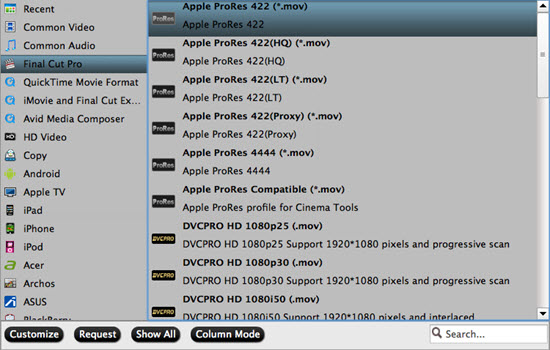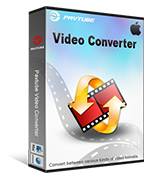Converting Canon 5D Mark IV 4K videos to FCP X for smooth editing
Category : 4K Cameras , 4K MOV , Final Cut Pro
The Canon EOS 5D Mark IV is a semi-professional 30.1 megapixels full-frame digital single-lens reflex (DSLR) camera made by Canon. There is no doubt Canon 5D Mark IV can record 4K video easily.
About Canon 5D Mark IV 4K recording
4K recording has become essential in the current generation of high-end cameras; it delivers far more detail than HD and allows the ability to extract 8-megapixel images. Like the 1DM2, Canon skips the popular UHD 4K format (3,840 x 2,160), instead supporting just cinema-focused DCI (4,096 x 2,160). Most cameras that offer DCI also offer UHD, in part because the two formats have different aspect ratios: UHD’s TV-friendly 1.78 vs. DCI’s 1.9. The 5DM4 also inherits the HDR movie capability Canon first incorporated into the 80D, which shoots each 1080/60p video frame at two exposures, then combines them for a single 1080/30p frame.
The Mark IV 4K mode uses a different video codec and format like MOV, MP4, so the video files are pretty massive. If you have recorded some 4K videos from Canon 5D Mark IV, they are must be the 4K MOV format. If you want to import and edit Canon 5D Mark IV 4K MOV with FCP X without any problems, we suggest you learing the following solution for editing.
Popular search: Canon EOS 5D Mark IV 4K to DaVinci Resolve ǀ Canon 5D Mark IV 4K MOV with Avid MC ǀ Canon EOS 5D Mark IV 4K to Sony Vegas Pro/Movie Studio ǀ Canon 5D Mark IV Review
Best solution for can’t import Canon 5D Mark IV 4K videos to FCP X
To solve the problem, you need to change the file extentsion from “.mov” to “a codec” that FCP X can read more easily (without rendering basically). The codec is Apple ProRes, which ensures maximum editing quality and efficiency when working with Final Cut Pro X(read FCP X supported formats ). To transcode Canon EOS 5D Mark IV 4K files to ProRes MOV, Pavtube HD Video Converter for Mac is an easy-to-use yet professional app to achieve your goal smoothly. Overall, the Canon 5D Mark IV to FCP X Converter is clean and safe to install and use. And only with barely several mouse clicks, you can get the whole job done.
Besides Canon EOS 5D Mark IV 4K MOV, it can also change more video file formats like SD/4K MTS, MXF, XAVC, XAVC S, XVAC L, AVCHD MTS/M2TS, MKV to Final Cut Pro X most compatible Apple ProRes .mov without any quality loss. Also has the ability to compress 4K to 1080p or upsacle 1080p to 4K for your more usages. Now download it and follow below steps to transcode Canon 5D Mark IV 4K MOV files to Final Cut Pro X.
Free download the 4K to FCP X Transcoder for Mac:
Other Download:
- Pavtube old official address: http://www.pavtube.com/hd-video-converter-mac/
- AppStore Download: https://itunes.apple.com/de/app/pavtube-hd-video-converter/id502792488?mt=12
- Cnet Download: http://download.cnet.com/Pavtube-HD-Video-Converter/3000-2194_4-76177786.html
Guide: Transcode and Import Canon 5D Mark IV 4K files to Final Cut Pro X
Step 1: Add Canon 5D Mark IV 4K videos
Install the Canon 5D Mark IV 4K to Final Cut Pro X converter program on Mac and run it. Drag the Canon 5D Mark IV 4K clips to the software. Or you can also click “Add video” button on the top of the main interface to import video to the program.

Step 2: Choose FCP X compatible format
Go to “Format” bar and choose “Final Cut Pro > Apple ProRes 422 (*.mov)” as output format for Final Cut Pro X/7/6.

Actually, different Apple ProRes codec corresponds to different needs:
Apple ProRes 422 (HQ)– Higher quality than Apple ProRes 422 (LT);
Apple ProRes 422 – Keep original video quality for editing in FCP;
Apple ProRes 422 (LT) – Get a smaller file sizes than Apple ProRes 422;
Apple ProRes 422 (Proxy) – SD levels – 480i/p and 576i/p. Used in offline workflows.
Apple ProRes 4444 – Edit and finish 4:4:4 material.
Step 3: Start Canon 5D Mark IV 4K to ProRes conversion
Click the “Convert” button at the bottom right corner to start transcoding Canon 5D Mark IV 4K files for FCP. It does Canon 5D Mark IV 4K to FCP X video conversion like a charm and the output files will maximally preserve the quality of your original Canon 5D Mark IV 4K clips. After conversion, you can import converted Canon 5D Mark IV 4K clips into Final Cut Pro X or FCP 7/6 to create the end results that you want.
Additional Tips:
a. If the default settings do not fit your needs, you can click “Settings” button to customize output video parameters like bitrate, channels, frame rate, etc, such as to set higher bitrate to get much better image quality. In general, the higher video bit rate, the larger output file size, and vice versa.
b. You can use the video editor designed in this FCP X Video Converter to edit your original videos. Click “Edit” on the main interface, and edit your videos by trimming (get/cut off video clips), cropping (remove unwanted areas), adding text/image/video watermarks, inserting subtitles, adding special effects, etc.
c. If you want to edit Canon 5D Mark IV 4K in iMovie, you just need to choose the “iMovie and Final Cut Express > Apple InterMediate Codec (AIC) (*.mov)” in the second step.
d. If you want to batch conversion, the professional 4K to FCP X Converter for Mac is the best choice for you. Just Go to “Merge into one File” tab to realize batch convert Canon 5D Mark IV 4K videos.
Note: If you are also a FCP X user, before you try to do the conversion, don’t forget to make sure that you have installed the Apple ProRes Codec manually since the FCP X asks users to install it by themselves.
New features over the EOS 5D Mark III are:
DCI 4K (4096×2160) with up to 30 fps (29.94 fps) up to 29’59”, with crop 1.74x (compared to full frame).
Full HD video (1080p) up to 60 fps, HD (720p) up to 120 fps
Continuous shooting rate of up to 7.0 frames per second with full autofocus; 4.3 fps in live view with autofocus by Dual Pixel CMOS AF
All AF points support to a maximum aperture of f/8, 61 points high density reticular AF II system including 41 cross-type points, center point is sensitive down to EV -3; AF area expanded vertically.
Continuous red illumination of all AF points
Intelligent Viewfinder II
Inherited AI Servo AF III with EOS iTR AF from EOS 7D Mark II and EOS-1D X Mark II
Built-in GPS used for geotag information and syncing to UTC time: compatible with three satellite navigation systems including GLONASS, GPS, Michibiki
Standard ISO range expanded from 100-25600 at Mark III to 100-32000.
Anti-flicker feature (introduced with the EOS 7D Mark II and EOS-1D X Mark II) – camera can be set to adjust the moment of exposure to compensate for flickering electric lighting
A touchscreen LCD, which allows videographers to select the camera’s AF point before and during video recording.
Wi-Fi, NFC for wireless file transfer (with wireless transmitter)
Mirror Vibration Control System
“Fine Detail” picture style
Dual Pixel CMOS AF with Dual Pixel RAW: for bokeh shift, microadjustments, reduces ghost and flare
Digital lens optimizer for JPEG shooting, inherited from the EOS-1D X Mark II
Time-lapse movie features
900 shot battery life (approx)
100% viewfinder
Magnification: 0.71















